How To Install AN Fittings To Rubber Braided Hose
Today, we will show you how to install AN fittings on rubber braided hose, the best practices, the tools needed, and any other information you need to build your first AN hose.
This guide will only work for stainless steel or nylon braid over rubber hose. We will release guides for both shortly if you want to install a PTFE or rubber push-lock hose.
We have sold AN hose and fittings for a few years, and this subject always comes up in conversation. So, we released a video on the different types of AN fittings, their uses, and how to install each one. I've added the video here if you would rather watch the AN fittings being installed.
Now, let's move on to the tools we need to start installing your new shiny AN fittings and hose.
Tools Needed To install AN Fittings:
You will need a few tools to start installing AN fittings. Some of these are optional but nice to have. We always recommend going with the optional list, as this gives a much cleaner look and, more importantly, will not damage the AN fittings, which is very common.
If used correctly, AN spanners and vice jaws ensure you don't damage or scratch the AN fittings when installing.
AN Parts needed:
- 2 x Swivel Hose End AN fittings
- A length of braided rubber hose longer than you need to cut to size
Tools Needed:
- A vice installed on a bench
- A roll of masking tape
- A tin of WD40 or grease
- A microfibre or clean cloth
- A tape measure
- A disc cutter with a 1mm cutting disc
- Goggles or eye protection
- A spanner in the correct size for the AN fittings
Optional Tools:
- Aluminium AN Spanner
- Aluminium AN vice jaws
1. Cutting The Braided Rubber Hose
You will need to start by cutting the AN braided rubber hose to the correct length you need. Measure the correct length for your application using the tape measure and wrap masking tape around the hose on both ends, with the cut line in the centre of the hose.
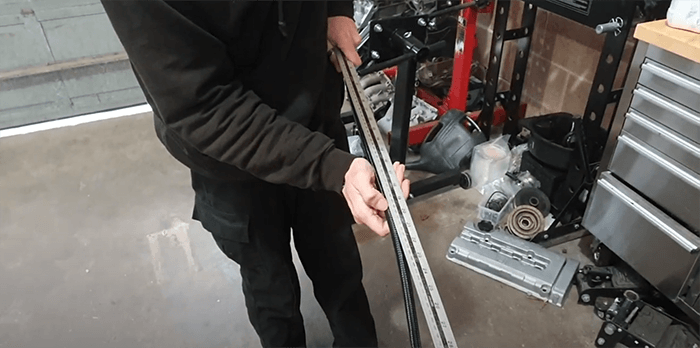
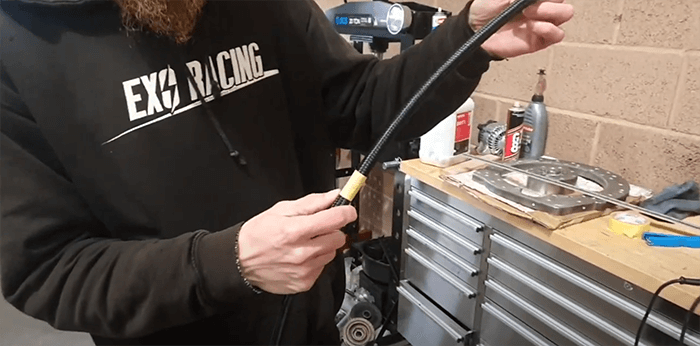
Place the cloth in the vice and put the hose in, making sure the cloth is centred correctly. Place the centre point of the masking tape end with around 10-15mm of overlap over the end of the vice to ensure the hose does not move when cutting it.
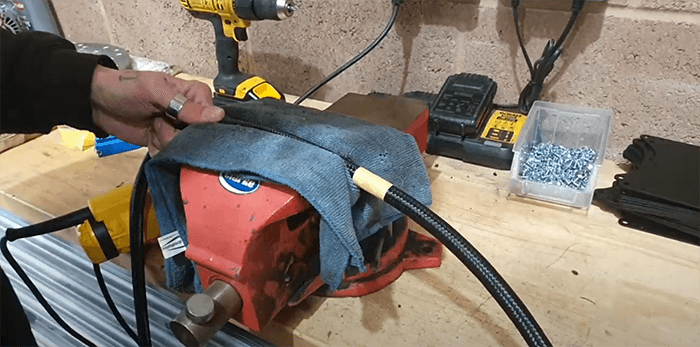
You will use masking tape because cutting through the hose without it will cause the ends to fray and make it difficult to install the AN fittings. This method keeps the braided tightly together and makes installation a breeze.
Put on the goggles or eye protection and set up the disc cutter with a 1mm cutting disc.
Cut through the braided rubber hose, getting the cleanest, straightest cut directly through the centre of the masking tape.
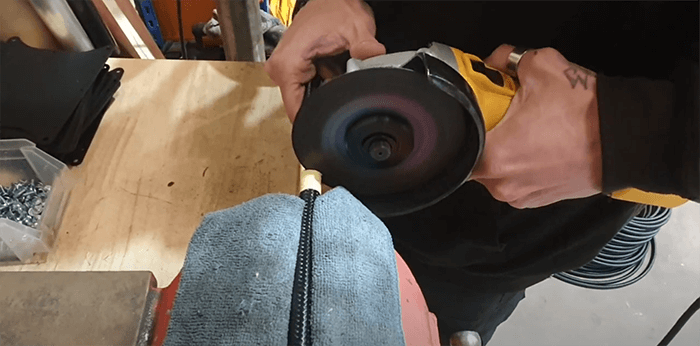
Check to make sure there is no swarf from the inner braid inside the line, as this can damage your engine or components. At the very least, these swarf particles could get inside the threads and damage the fitting when installing them to the ends of the line.
Repeat this step for the other end of the braided hose, and you will now have a perfectly straight and clean cut, ready to start installing the fittings.
2. Installation Of The AN Fitting To The Hose
First, before moving on to the part where you install the AN fitting, you will want to double-check to ensure you have the correct fitting and size for the hose. Once you have confirmed this is correct, follow the instructions below to install them on your hose.
Unscrew the end off of the AN fitting and push it over the braided hose as far as it will go until it reaches the lip inside the hose end. If you aren't too sure about this, look inside the fitting. You will see a lip where the hose has been fully pushed up against to prevent leakage.
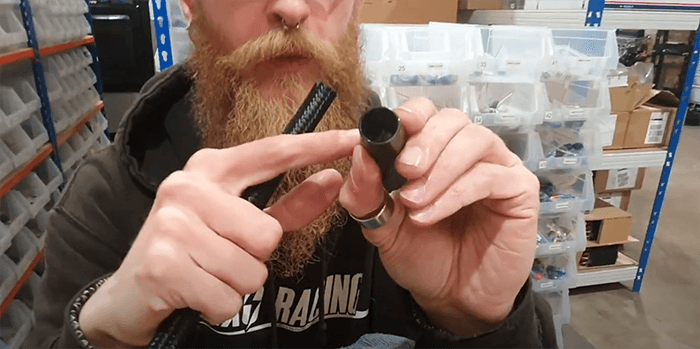
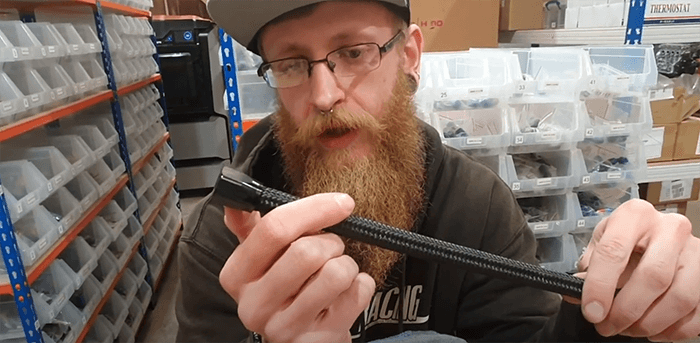
Once this end has been pushed tight and fully seated against the hose, place the hose end in the vice (ideally using the Aluminium AN vice jaws).
Use either the WD40 or grease on the threads of the male end to make installation a little bit easier, and start screwing the fitting in by hand, making sure not to cross-thread it.
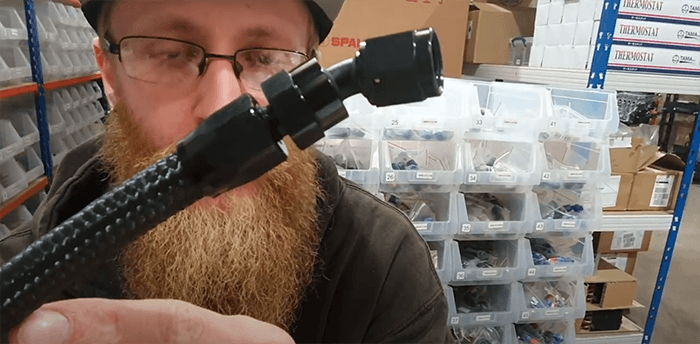
Once it has started to get tight, use the AN spanner or a normal spanner with a cloth to avoid scratching and tighten the fitting until it fully sits against the hose end. There should not be a gap here, and the hose should still be fully seated against the lip.

An important note to make this easier is to try not to stop turning with the AN spanner, as we have found this to be much easier than stopping intermittently.
Repeat these steps on the other side of the braided rubber hose after fully installing the AN fitting onto the braided hose. Provided the hose is seated correctly, you have made your first AN line!
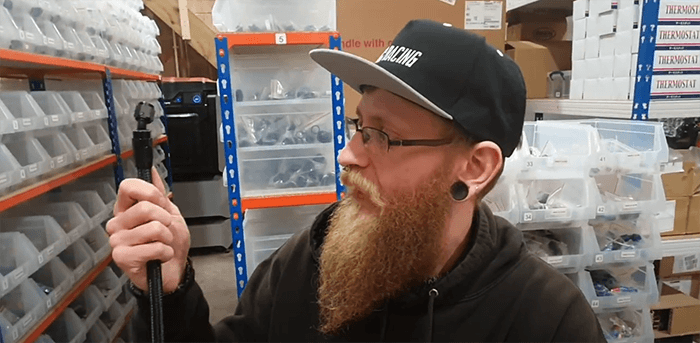
To prevent problems later, check your hose for leaks before installing it in your car using a pressure testing kit.
Frequently Asked Questions:
Q. What is the difference between push-lock, PTFE or braided rubber hose?
A. Rubber push-lock hoses are used for fluid transfer, such as coolant or oil. They only have a rubber outer and use push-on fittings with clamps or jubilee clips. We have covered braided rubber hoses in this guide, which are suitable for E5 fuels, oil, coolant, etc.
PTFE hose is used for anything more aggressive, such as e85, race fuels, etc., or for lines that have to run through the car, as you will not leak excess fuel vapour with PTFE due to the composition of the material.
Q. Can I use PTFE or Push lock fittings on rubber braided hose?
A. No, you cannot. You must use the correct AN rubber fittings for the braided stainless or nylon rubber hose. The other fitting styles will not seal correctly, and you could have a potential leak, so please use the correct fittings with the correct hose.
If you need more information, head to our ultimate AN fittings guide, which covers this in more detail.
Q. Should I use stainless steel or nylon braided hose?
You can use whichever hose you need for your application, but using one over the other does have some benefits. The stainless steel outer braid is generally considered much stronger and less susceptible to rubbing than the nylon counterpart.
On the other hand, the nylon braided hose is much more flexible and can go around tighter corners than the stainless steel hose. They both have the same rubber inner, so the only difference is the outer.
Products Used In This Guide
We have used many products in this guide that we also sell, so if you are interested in purchasing or having a look before you order.
If you're on mobile scroll to the bottom of the page for the AN fittings, or the floating sidebar to the right on desktop.
Conclusion
Hopefully, you have made your first AN braided line and are confident in making the rest of your lines yourself!
If you have decided to click on any of the product links in this guide, then we have a specific discount code for our blog readers; use the code:
BLOG5
At the checkout for a 5% discount off the entire order!
Have a look at some of our other articles below, which also may be useful for you:
- The ultimate AN fittings guide
- What does an oil catch can do?
- What is a swirl pot?
- How to install heat reflective tape
- How to install titanium intake exhaust studs
- How to install PTFE fittings
If you are still unsure about any of the installation steps in this guide or need some advice on which parts you will need, please don't hesitate to contact us. We will be happy to help!
There is a rule, custom laptop is called programming laptop cause nearly 90% is used for projects. 15.6 inch laptop for coding and programming is usually equipped with 10th or 11th cpu, 2gb or 4gb graphics optional. 15 inch laptop untuk programming is used on big tender or group for a special jobs. 15.6 inch programming laptop under 30000 is a more competitive one for business or high school students or teachers.
However, here is the recommended laptop for programming, especially for heavy office jobs or university coursework, since double heat-releasing, metal body, bigger battery, FHD screen, high-level cpu, etc. Build the deep and stable foundation to enjoy smooth running experience. Your clients will satisfy it`s excellent performance. Of course, there are other lower specification with tight budget.
As a entry windows laptop for programming, this 14 inch celeron Education Laptop is the most competitive and hottest device for elementary project.
Any other special requirements, just contact us freely.
Programming Laptop,Laptop For Coding And Programming,Programming Laptop Under 30000,Recommended Laptop For Programming,Windows Laptop For Programming
Henan Shuyi Electronics Co., Ltd. , http://www.shuyielectronics.com